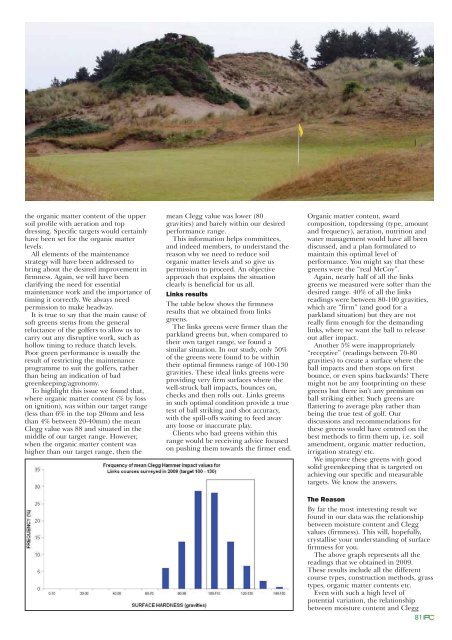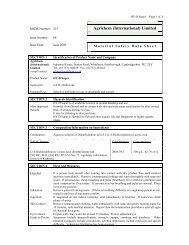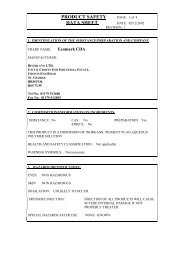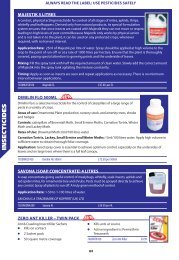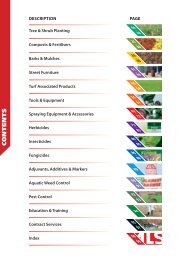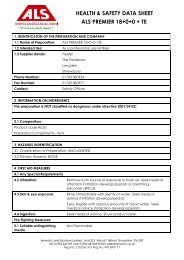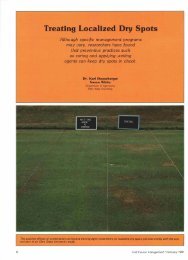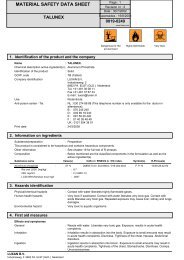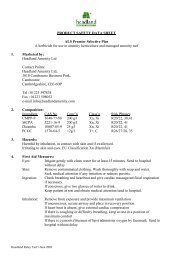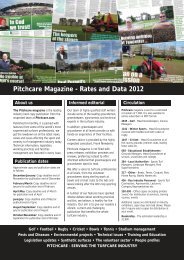Earning his Spurs - Pitchcare
Earning his Spurs - Pitchcare
Earning his Spurs - Pitchcare
Create successful ePaper yourself
Turn your PDF publications into a flip-book with our unique Google optimized e-Paper software.
the organic matter content of the upper<br />
soil profile with aeration and top<br />
dressing. Specific targets would certainly<br />
have been set for the organic matter<br />
levels.<br />
All elements of the maintenance<br />
strategy will have been addressed to<br />
bring about the desired improvement in<br />
firmness. Again, we will have been<br />
clarifying the need for essential<br />
maintenance work and the importance of<br />
timing it correctly. We always need<br />
permission to make headway.<br />
It is true to say that the main cause of<br />
soft greens stems from the general<br />
reluctance of the golfers to allow us to<br />
carry out any disruptive work, such as<br />
hollow tining to reduce thatch levels.<br />
Poor green performance is usually the<br />
result of restricting the maintenance<br />
programme to suit the golfers, rather<br />
than being an indication of bad<br />
greenkeeping/agronomy.<br />
To highlight t<strong>his</strong> issue we found that,<br />
where organic matter content (% by loss<br />
on ignition), was within our target range<br />
(less than 6% in the top 20mm and less<br />
than 4% between 20-40mm) the mean<br />
Clegg value was 88 and situated in the<br />
middle of our target range. However,<br />
when the organic matter content was<br />
higher than our target range, then the<br />
mean Clegg value was lower (80<br />
gravities) and barely within our desired<br />
performance range.<br />
T<strong>his</strong> information helps committees,<br />
and indeed members, to understand the<br />
reason why we need to reduce soil<br />
organic matter levels and so give us<br />
permission to proceed. An objective<br />
approach that explains the situation<br />
clearly is beneficial for us all.<br />
Links results<br />
The table below shows the firmness<br />
results that we obtained from links<br />
greens.<br />
The links greens were firmer than the<br />
parkland greens but, when compared to<br />
their own target range, we found a<br />
similar situation. In our study, only 50%<br />
of the greens were found to be within<br />
their optimal firmness range of 100-130<br />
gravities. These ideal links greens were<br />
providing very firm surfaces where the<br />
well-struck ball impacts, bounces on,<br />
checks and then rolls out. Links greens<br />
in such optimal condition provide a true<br />
test of ball striking and shot accuracy,<br />
with the spill-offs waiting to feed away<br />
any loose or inaccurate play.<br />
Clients who had greens within t<strong>his</strong><br />
range would be receiving advice focused<br />
on pushing them towards the firmer end.<br />
Organic matter content, sward<br />
composition, topdressing (type, amount<br />
and frequency), aeration, nutrition and<br />
water management would have all been<br />
discussed, and a plan formulated to<br />
maintain t<strong>his</strong> optimal level of<br />
performance. You might say that these<br />
greens were the “real McCoy”.<br />
Again, nearly half of all the links<br />
greens we measured were softer than the<br />
desired range. 40% of all the links<br />
readings were between 80-100 gravities,<br />
which are “firm” (and good for a<br />
parkland situation) but they are not<br />
really firm enough for the demanding<br />
links, where we want the ball to release<br />
out after impact.<br />
Another 5% were inappropriately<br />
“receptive” (readings between 70-80<br />
gravities) to create a surface where the<br />
ball impacts and then stops on first<br />
bounce, or even spins backwards! There<br />
might not be any footprinting on these<br />
greens but there isn’t any premium on<br />
ball striking either. Such greens are<br />
flattering to average play rather than<br />
being the true test of golf. Our<br />
discussions and recommendations for<br />
these greens would have centred on the<br />
best methods to firm them up, i.e. soil<br />
amendment, organic matter reduction,<br />
irrigation strategy etc.<br />
We improve these greens with good<br />
solid greenkeeping that is targeted on<br />
achieving our specific and measurable<br />
targets. We know the answers.<br />
The Reason<br />
By far the most interesting result we<br />
found in our data was the relationship<br />
between moisture content and Clegg<br />
values (firmness). T<strong>his</strong> will, hopefully,<br />
crystallise your understanding of surface<br />
firmness for you.<br />
The above graph represents all the<br />
readings that we obtained in 2009.<br />
These results include all the different<br />
course types, construction methods, grass<br />
types, organic matter contents etc.<br />
Even with such a high level of<br />
potential variation, the relationship<br />
between moisture content and Clegg<br />
81


